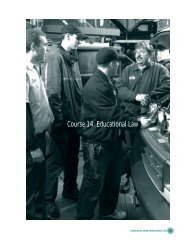Facilitating
Teaching and Facilitating Learning - Level 2 - Washington State ...
Teaching and Facilitating Learning - Level 2 - Washington State ...
- No tags were found...
Create successful ePaper yourself
Turn your PDF publications into a flip-book with our unique Google optimized e-Paper software.
○ ○ ○ ○ ○ ○ ○ ○ ○ ○ ○ ○ ○ ○ ○ ○ ○ ○ ○ ○ ○ ○ ○ ○ ○ ○ ○ ○ ○ ○ ○ ○ ○ ○ ○ ○ ○ ○ ○ ○ ○ ○ ○ ○ ○ ○ ○ ○ ○ ○ ○ ○ ○ ○ ○ ○ ○ ○ ○ ○ ○ ○ ○ ○ ○ ○ ○ ○ ○ ○ ○ ○ ○ ○ ○ ○ ○ ○ ○ ○ ○ ○tends to see themes, problems and issues in groups ) or clusters. He then spends considerabletime thinking about and preparing opening questions for each area, asking himself suchquestions as (p.111):• ‘Do I want to open with a shocking question, designed to surprise the students into reallyimaginative thinking? Or should I choose instead a much more predictable beginning.How is this work like?“What in this work did you find confusing, important, or notable?”• “Should I perhaps open the discussion in a low-key way by simply asking what issuesthe students want to talk about, what questions they want answered?”• “Should I focus on a particular moment in the text or use it as a way of discussing crucialthemes or problems?”• “Should I begin with a context-specific question that has important subtextualramifications?”He also thinks about which students he might call upon based on their relevant past experiences,completion of related writing assignments, or their recent silence in class.LISTENINGHuston believes the cornerstone of effective discussion is “the ability to listen to students’answers [and] to hear what the students are really saving, not what the teacher expects themto say” (p. 109). He also understands and acknowledges that teachers often frame questionswith a definite answer in mind which makes it easy to impose that answer on studentcomments and/or to dismiss a student answer in search of one more closely aligned withwhat teachers want to hear. While this may be acceptable in a test, in discussion settings,Huston explains, “It does not take students long to realize that what they are being asked todo is not to discuss, not to think their own ideas, but to read the teacher’s mind” (p. 109).IMPROVISATIONAnother essential discussion skill is the ability to improvise, which allows teachers to usediscussion to build on the ideas as they come from students” (p.109). What makes this hardfor many who lecture well is that the method places little importance on organization. InHuston’s case, discussions move between, across and around clusters of issues he hasidentified for discussion.Though discussions may need to be summarized and/or organized with separate ideasrelated, that should not take place as they are occurring. At that point, the sense of explorationand discovery serve as the appropriate forces that drive the discussion from point topoint. ‘While the discussion teacher can be less concerned than the lecturer with organization,s/he must be more focused on the process, constantly monitoring the ebb and flow ofideas. For Huston it’s an ongoing subtext of questions:• Who’s prepared?• Is the material interesting most of them?• Do they understand the reading?• Who wants to participate?• Who’s carrying the discussion?• Should I call on one of my best students to give the class a lift? Or can a quieter personshine on this issue?2.24CURRICULUM GUIDE: TEACHING & FACILITATING LEARNING - LEVEL 1I




